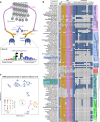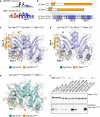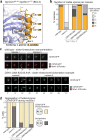The molecular basis of monopolin recruitment to the kinetochore
- PMID: 31037469
- PMCID: PMC6823300
- DOI: 10.1007/s00412-019-00700-0
The molecular basis of monopolin recruitment to the kinetochore
Abstract
The monopolin complex is a multifunctional molecular crosslinker, which in S. pombe binds and organises mitotic kinetochores to prevent aberrant kinetochore-microtubule interactions. In the budding yeast S. cerevisiae, whose kinetochores bind a single microtubule, the monopolin complex crosslinks and mono-orients sister kinetochores in meiosis I, enabling the biorientation and segregation of homologs. Here, we show that both the monopolin complex subunit Csm1 and its binding site on the kinetochore protein Dsn1 are broadly distributed throughout eukaryotes, suggesting a conserved role in kinetochore organisation and function. We find that budding yeast Csm1 binds two conserved motifs in Dsn1, one (termed Box 1) representing the ancestral, widely conserved monopolin binding motif and a second (termed Box 2-3) with a likely role in enforcing specificity of sister kinetochore crosslinking. We find that Box 1 and Box 2-3 bind the same conserved hydrophobic cavity on Csm1, suggesting competition or handoff between these motifs. Using structure-based mutants, we also find that both Box 1 and Box 2-3 are critical for monopolin function in meiosis. We identify two conserved serine residues in Box 2-3 that are phosphorylated in meiosis and whose mutation to aspartate stabilises Csm1-Dsn1 binding, suggesting that regulated phosphorylation of these residues may play a role in sister kinetochore crosslinking specificity. Overall, our results reveal the monopolin complex as a broadly conserved kinetochore organiser in eukaryotes, which budding yeast have co-opted to mediate sister kinetochore crosslinking through the addition of a second, regulatable monopolin binding interface.
Keywords: Kinetochore; Meiosis; Monopolin; RWD domain.
Figures







References
-
- Afonine Pavel V., Grosse-Kunstleve Ralf W., Echols Nathaniel, Headd Jeffrey J., Moriarty Nigel W., Mustyakimov Marat, Terwilliger Thomas C., Urzhumtsev Alexandre, Zwart Peter H., Adams Paul D. Towards automated crystallographic structure refinement withphenix.refine. Acta Crystallographica Section D Biological Crystallography. 2012;68(4):352–367. doi: 10.1107/S0907444912001308. - DOI - PMC - PubMed
Publication types
MeSH terms
Substances
Grants and funding
LinkOut - more resources
Full Text Sources
Molecular Biology Databases

